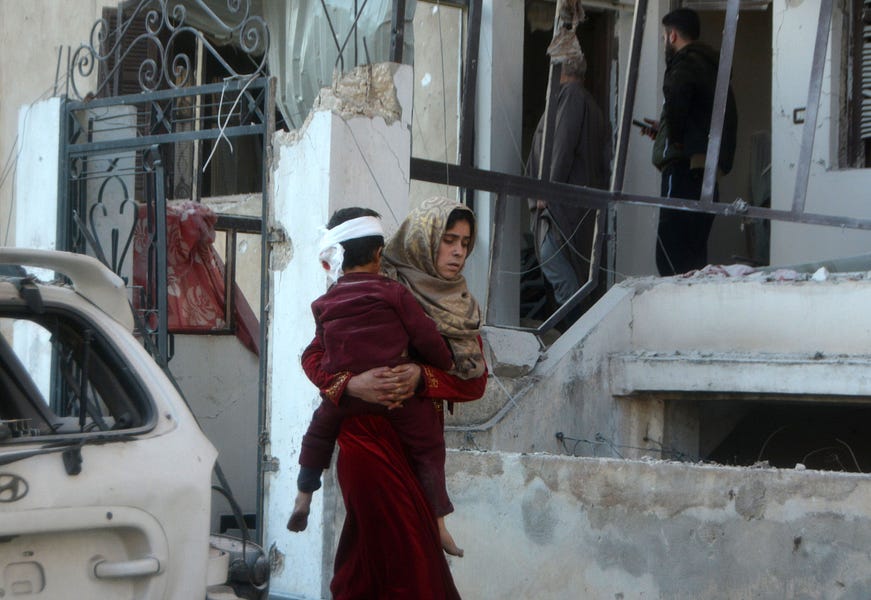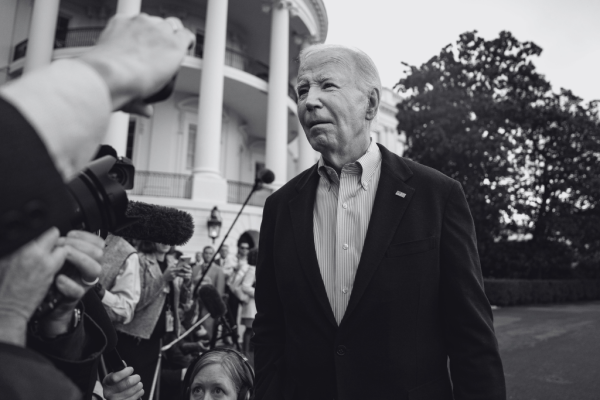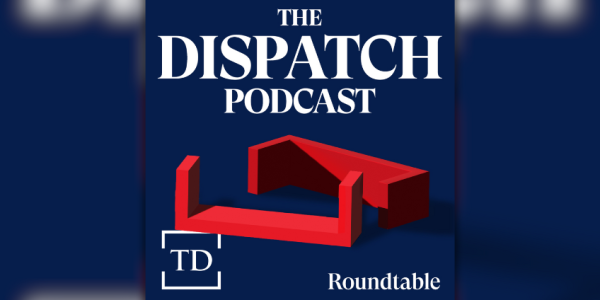There is a scene in the award-winning Syrian war documentary For Sama in which two small boys arrive at a makeshift hospital with their little brother. The grimy, dust-covered children hang their heads in their hands in despair and fear as doctors examine the small body. But the child is dead, killed in the battle of Aleppo. In showings around Washington—including at the Department of State—there was hardly a dry eye as these small boys confronted death. This is what hell looks like, feels like.
Yet few can spare a thought for the million people that, as I write, are fleeing Idlib, the last redoubt of anti-Assad forces in Syria. Most are women and children, and they have nowhere to go. The Turkish border is closed, and heavily armed. On the other side are Assad’s forces, Hezbollah, and the Russian air force. The United Nations has run out of supplies. Some children have frozen to death. Those being captured are being tortured and killed. The world is doing almost nothing—with the United States and European leaders mouthing pointless pleas for diplomacy and dialogue.
How is it possible that in this day and age, half a million people can die, 7 million can be internally displaced, with almost as many having fled, and yet the killing can go on and on, as the great powers of the world stand by? Or is that having numbed ourselves to the horror of the nine-year-old Syrian war, another million here or there simply do not matter? Of course, we know the answer. They don’t. How did the civilized world come to such a pass, again? The answer is … Slowly.
In 2015, the Washington Post’s editorial page editor, Fred Hiatt, wrote a piece that encapsulated the problem that had come before and has grown since:
Perversely, the worse Syria became, the more justified the president [Obama] seemed for staying aloof; steps that might have helped in 2012 seemed ineffectual by 2013, and actions that could have saved lives in 2013 would not have been up to the challenge presented by 2014. […] Most critically, inaction was sold not as a necessary evil but as a notable achievement: The United States at last was leading with the head, not the heart, and with modesty, not arrogance.
From the very beginning, the Obama administration was indifferent to the fate of Syria, notwithstanding its position at the intersection of moral and strategic interests. The Syrian people were standing up to a brutal dictator, Iran’s most important Arab ally and a godfather of global terrorism in his own right. As the war spiraled out of control and outside powers intervened—Iran, Hezbollah, al-Qaeda, ISIS and the Russians to name but a few—the appetite for any sort of action diminished. Only 500 U.S. soldiers remain, the rump of the ISIS-fighting force, nominally present to “protect oil fields.”
Donald Trump’s decision to abandon the the Kurds, our most important ally against ISIS, so that Turkish proto-dictator Recep Tayyip Erdogan could invade northeastern Syria to counter what he described as “terrorists” created the opportunity Assad and his allies had been looking for to crush the last corner of resistance. And to be fair, Idlib is not simply a crush of desperate and decent humanity. It remains home to some of the worst of the Salafi-jihadi movement. Those groups were under tight control before the Kurds came under attack.
At this point, Russians are killing Turkish troops. Syrian forces are advancing. Iran and Hezbollah taste victory. As a matter of public policy, the argument now boils down to the argument that Syria is lost and the best that can be hoped for is the return of the Assad regime, allowing Iran its beachhead in the Levant, and Russia its bases on the Mediterranean. Not so fast.
It’s true that Syria is close to lost for most of the Syrian people, but Assad will not be able to eradicate his enemies (good and bad) completely, and so the war will continue in some form. Syrians, as they are now, will be the worst hit. But there are still options available to the international community, and they can halt the wholesale slaughter, roll back the Russians and potentially even flip the Turks.
Job one is to stop Assad in his tracks, preferably with a cease-fire, the violation of which must cause substantial pain not only to Assad and his Iranian backers, but also to Russia. The second—unfortunately, given what a bad actor Erdogan has been—is to backstop Turkey’s efforts to fend off Russia with a view to reversing Russia’s gains in Syria and reuniting Erdogan with the aims of his NATO allies.
The notion of helping Erdogan, who has driven Turkey to the outer bounds of NATO and enjoyed Putin’s warm embrace, is galling. But this can be a win-win. Erdogan wants help with surface-to-air support to deter Russia’s close air support for Assad. Ironically, he has just the surface-to-air equipment he needs—the S400 system he bought from Russia to the horror of his NATO allies—but it’s not yet deployed. And Erdogan really prefers what the United States can offer. That’s fine; he can give back the S400s and get some decent equipment from the good guys. Erdogan also reportedly wants back those lovely Patriot missiles that defended him a few years back. That’s fine, too. Give Russia back their S400s and stop targeting the Syrian Democratic Forces (SDF) who have long supported U.S. counter-ISIS operations in Syria.
Erdogan also wants the U.S. to support him with some air combat patrols. There will be some reluctance in Washington, but the payoff is potentially large if we can push back on Russia and free up the SDF. First, despite reporting suggesting the Assad/Iran/Russian forces are a juggernaut flattening all of Syria, the truth is that Russia’s abilities are limited. Before Erdogan’s latest dalliance with Putin, Turkish forces shot down a Russian jet. And note, that did not result in World War III. Putin is in this game because there has been little resistance, and likely has little appetite for a shooting war. So, yes, air patrols are a good idea, if Turkey is willing to do the right thing. Second, freeing the SDF from Turkish predations and allowing them back to the counter-ISIS battle would be a win for the United States.
What else? It’s time for Erdogan to bail on the Astana process, the Russian-Turkish-Iranian talks to “solve” the Syria problem. They’ve delivered no solutions, and have become a façade for a wholesale Iranian/Russian-dictated end to the crisis. Germany and France have offered Putin and Erdogan talks aimed at a cease fire. Putin demurred. He also nixed a bilateral with Erdogan. He wants Astana, and it’s time to tell him that’s over.
In short, there may be no enthusiasm in Washington or anywhere else to help the Syrian people. But perhaps a little strategic thinking about the opportunity for a small victory against Russia and Iran, not to speak of the opportunity to re-enlist Erdogan on the side of good, will tempt the powers that be to do the right thing. I pray it might.
Danielle Pletka is a senior fellow at the American Enterprise Institute. Thanks to AEI’s Fred Kagan and the Institute for the Study of War’s Jennifer Cafarella for their expertise.
Photograph of a woman carrying an injured child following an air strike by pro-Syrian regime forces in the town Idlib province by Mohammed Al-Rifai/AFP/Getty Images.








Please note that we at The Dispatch hold ourselves, our work, and our commenters to a higher standard than other places on the internet. We welcome comments that foster genuine debate or discussion—including comments critical of us or our work—but responses that include ad hominem attacks on fellow Dispatch members or are intended to stoke fear and anger may be moderated.
You are currently using a limited time guest pass and do not have access to commenting. Consider subscribing to join the conversation.
With your membership, you only have the ability to comment on The Morning Dispatch articles. Consider upgrading to join the conversation everywhere.